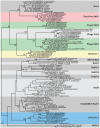Stalking the fourth domain in metagenomic data: searching for, discovering, and interpreting novel, deep branches in marker gene phylogenetic trees
- PMID: 21437252
- PMCID: PMC3060911
- DOI: 10.1371/journal.pone.0018011
Stalking the fourth domain in metagenomic data: searching for, discovering, and interpreting novel, deep branches in marker gene phylogenetic trees
Abstract
Background: Most of our knowledge about the ancient evolutionary history of organisms has been derived from data associated with specific known organisms (i.e., organisms that we can study directly such as plants, metazoans, and culturable microbes). Recently, however, a new source of data for such studies has arrived: DNA sequence data generated directly from environmental samples. Such metagenomic data has enormous potential in a variety of areas including, as we argue here, in studies of very early events in the evolution of gene families and of species.
Methodology/principal findings: We designed and implemented new methods for analyzing metagenomic data and used them to search the Global Ocean Sampling (GOS) expedition data set for novel lineages in three gene families commonly used in phylogenetic studies of known and unknown organisms: small subunit rRNA and the recA and rpoB superfamilies. Though the methods available could not accurately identify very deeply branched ss-rRNAs (largely due to difficulties in making robust sequence alignments for novel rRNA fragments), our analysis revealed the existence of multiple novel branches in the recA and rpoB gene families. Analysis of available sequence data likely from the same genomes as these novel recA and rpoB homologs was then used to further characterize the possible organismal source of the novel sequences.
Conclusions/significance: Of the novel recA and rpoB homologs identified in the metagenomic data, some likely come from uncharacterized viruses while others may represent ancient paralogs not yet seen in any cultured organism. A third possibility is that some come from novel cellular lineages that are only distantly related to any organisms for which sequence data is currently available. If there exist any major, but so-far-undiscovered, deeply branching lineages in the tree of life, we suggest that methods such as those described herein currently offer the best way to search for them.
Conflict of interest statement
Figures



References
-
- Balch WE, Magrum LJ, Fox GE, Wolfe RS, Woese CR. An ancient divergence among the bacteria. J Mol Evol. 1977;9:305–311. - PubMed
-
- Fox GE, Stackebrandt E, Hespell RB, Gibson J, Maniloff J, et al. The phylogeny of prokaryotes. Science. 1980;209:457–463. - PubMed
-
- Pace NR. A molecular view of microbial diversity and the biosphere. Science. 1997;276:734–740. - PubMed
Publication types
MeSH terms
Substances
LinkOut - more resources
Full Text Sources
Other Literature Sources

